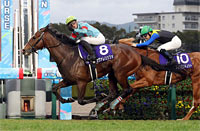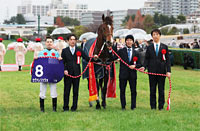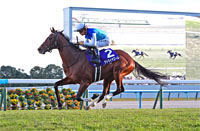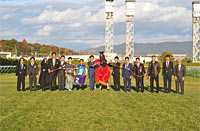Asahi Hai Futurity Stakes (G1) - Data Analysis
Champion decider contested by promising 2-year-olds
The 30 winners of the JRA Award for Best Two-Year-Old Colt since 1988 all won the Asahi Hai Futurity Stakes (operated under the name Asahi Hai Sansai Stakes until 2000) of the same year. A victory in the Asahi Hai Futurity Stakes has in many cases paved the way for multiple G1 triumphs, including for Mihono Bourbon (1991 winner), Narita Brian (1993 winner), Grass Wonder (1997 winner), Admire Don (2001 winner), Dream Journey (2006 winner), and Logotype (2012 winner). Which runner of the current 2-year-old generation will dominate this first G1 race and rise to the top? Let’s now analyze some features shared by successful runners in this race based on results over the last 10 years, including the period through 2013, when the race was held over 1,600m turf at Nakayama.
Favorable record in graded races and finish in previous race are key points
Of the 30 Top 3 finishers over the last 10 years, 21 runners had experience finishing in the Top 4 of a “JRA graded race between 1,400–1,800m.” These runners achieved a Top 3 ratio of 30.4%. In other words, we should focus on runners that have already enjoyed success in graded races over about a mile. [Table 1]
[Table 1] Performance by experience finishing in Top 4 of a “JRA graded race between 1,400–1,800m” (last 10 years)
| Experience |
Performance
[1st-2nd-3rd-4th or lower] |
Win ratio |
Top 2 ratio |
Top 3 ratio |
| Yes |
5-9-7-48 |
7.2% |
20.3% |
30.4% |
| No |
5-1-3-86 |
5.3% |
6.3% |
9.5% |
In addition, eight Top 3 finishers that had no experience finishing in the Top 4 of a “JRA graded race between 1,400–1,800m” (excluding 2012 third-place finisher Gottfried) had finished 1st in their last outings with a time difference of 0.2s or more with the runner-up in that race. When comparing runners that have not turned in strong performances in graded races with a distance of about a mile, we should raise our expectations of runners that have won their last outing with a time difference of 0.2s or more. [Table 2]
[Table 2] For runners with no experience of finishing in Top 4 of a "JRA graded race between 1,400–1,800m," performance by finish and time difference with runner-up in previous race (last 10 years)
Finish and time difference with
runner-up in previous race |
Performance
[1st-2nd-3rd-4th or lower] |
Win ratio |
Top 2 ratio |
Top 3 ratio |
First-place finish and time difference
with runner-up of 0.2s or more |
5-1-2-24 |
15.6% |
18.8% |
25.0% |
First-place finish and time difference
with runner-up of below 0.2s; or
second-place finish or lower |
0-0-1-62 |
0% |
0% |
1.6% |
Runners that were favorites in last outing are strong performers
An analysis of performance by favoritism in the previous race shows that runners backed as “1st favorite” in their last outing achieved an excellent Top 3 ratio of 35.0%. Meanwhile, runners backed as “6th favorite or lower” had a Top 3 ratio of only 4.9%. When comparing the runners’ previous races, we should check their favoritism. [Table 3]
[Table 3] Performance by favoritism in previous race (last 10 years)
Favoritism in
previous race |
Performance
[1st-2nd-3rd-4th or lower] |
Win ratio |
Top 2 ratio |
Top 3 ratio |
| 1st favorite |
6-3-5-26 |
15.0% |
22.5% |
35.0% |
| 2nd-5th favorite |
3-7-4-69 |
3.6% |
12.0% |
16.9% |
| 6th favorite or lower |
1-0-1-39 |
2.4% |
2.4% |
4.9% |
Runners that have suffered major defeats struggle
Of the 30 Top 3 finishers over the last 10 year, 23 runners had never been beaten to 5th or lower in a JRA race. Meanwhile, runners that had been beaten to 5th or lower in a JRA race struggled with a Top 3 ratio of 8.4%, which drops further to 4.5% if we confine our analysis to the races held from 2012 (performance of 0-1-1-42). This year, we should again lower our expectations of runners that have previously been beaten to 5th or lower. [Table 4]
[Table 4] Performance by experience of being beaten to 5th or lower in JRA race (last 10 years)
| Experience |
Performance
[1st-2nd-3rd-4th or lower] |
Win ratio |
Top 2 ratio |
Top 3 ratio |
| Yes |
1-3-3-76 |
1.2% |
4.8% |
8.4% |
| No |
9-7-7-58 |
11.1% |
19.8% |
28.4% |
Focus on runners that also contested a 1,600m race in their last outing
Of the 30 Top 3 finishers over the last 10 year, 15 runners had contested a “1,600m” race in their last outing. Meanwhile, runners that had contested a race with a distance “other than 1,600m” achieved a Top 3 ratio of only 13.0%. In other words, we should expect little from runners that have contested a race with a different distance than the Asahi Hai Futurity Stakes in their last outing. [Table 5]
[Table 5] Performance by distance of previous race (last 10 years)
Distance of
previous race |
Performance
[1st-2nd-3rd-4th or lower] |
Win ratio |
Top 2 ratio |
Top 3 ratio |
| 1,600m |
7-3-5-34 |
14.3% |
20.4% |
30.6% |
| Other than 1,600m |
3-7-5-100 |
2.6% |
8.7% |
13.0% |
In addition, the majority of the Top 3 finishers that had contested a race with a distance “other than 1,600m” in their last outing, ran in a JRA race in their last outing and were ranked “3rd or higher” in their estimated time over the final three furlongs in that race. Accordingly, runners that have contested a race with a different distance than the Asahi Hai Futurity Stakes in their last outing and ranked poorly in their estimated time over the final three furlongs in that race are likely to struggle. [Table 6]
[Table 6] For runners that contested a JRA “race with a distance other than 1,600m” in their last outing, performance by ranking in estimated time over the final three furlongs in that race (last 10 years)
Ranking in estimated time over final
three furlongs in previous race |
Performance
[1st-2nd-3rd-4th or lower] |
Win ratio |
Top 2 ratio |
Top 3 ratio |
| 3rd or higher |
2-6-5-47 |
3.3% |
13.3% |
21.7% |
| 4th or lower |
1-1-0-50 |
1.9% |
3.8% |
3.8% |
Runners with “large field” experience in last outing have enjoyed success in recent years
Of the eight Top 2 finishers over the last four years, seven runners (excluding 2014 runner-up Arma Waioli) had entered a race contested by “13 runners or more” in their last outing. Meanwhile, runners that had entered a race contested by “12 runners or less” in their last outing struggled with a Top 3 ratio of 9.5%. If we focus on trends since the Asahi Hai Futurity Stakes was first held over 1,600m at Hanshin, we should raise our expectations of runners with experience of running in a large field in their last outing. [Table 7]
[Table 7] Performance by number of runners in previous race (last four years)
Number of runners in
previous race |
Performance
[1st-2nd-3rd-4th or lower] |
Win ratio |
Top 2 ratio |
Top 3 ratio |
| 12 or less |
0-1-3-38 |
0% |
2.4% |
9.5% |
| 13 or more |
4-3-1-18 |
15.4% |
26.9% |
30.8% |
In addition, runners that entered a “race other than a JRA G2 race” contested by “12 runners or less” in their last outing had an even lower Top 3 ratio of 3.7%. This means we should definitely lower our expectations of runners with this kind of record. [Table 8]
[Table 8] For runners that entered a race contested by "12 runners or less" in their last outing, performance by condition of previous race (last 4 years)
Performance by
condition of previous race |
Performance
[1st-2nd-3rd-4th or lower] |
Win ratio |
Top 2 ratio |
Top 3 ratio |
| JRA G2 race |
0-1-2-12 |
0% |
6.7% |
20.0% |
| Race other than JRA G2 race |
0-0-1-26 |
0% |
0% |
3.7% |
Runners with fewest reasons for uncertainty are leading contenders
The last six winners all finished 1st in their last outing with a time difference of 0.2s or more with the runner-up in that race. Other features shared by the six winners were that they were backed as 4th favorite or higher in their previous race, that they had never been beaten to 5th or lower in a JRA race, and that they had entered a race contested by 13 runners or more in their previous race. In other words, we should focus on runners that clear many of the conditions outlined in Tables 1-8. [Table 9]
[Table 9] Winners' "finish in previous race," "time difference with runner-up in previous race," "favoritism in previous race," "lowest finish in JRA race," "number of runners in previous race" (last six years)
| Year |
Winner |
Finish in
previous race |
Time
difference with
runner-up in
previous race |
Favoritism in
previous race |
Lowest finish
in JRA race |
Number of
runners in
previous race |
| 2012 |
Logotype |
1st |
0.2s |
4th favorite |
4th (Sapporo Nisai Stakes, etc.) |
16 |
| 2013 |
Asia Express |
1st |
1.1s |
1st favorite |
1st (2 starts, 2 wins) |
16 |
| 2014 |
Danon Platina |
1st |
0.5s |
1st favorite |
2nd (September 6,
Newcomer @ Sapporo) |
13 |
| 2015 |
Leontes |
1st |
0.2s |
1st favorite |
1st (1 start, 1 win) |
15 |
| 2016 |
Satono Ares |
1st |
0.2s |
2nd favorite |
2nd (August 28, Maiden
@ Sapporo, etc.) |
13 |
| 2017 |
Danon Premium |
1st |
0.3s |
2nd favorite |
1st (2 starts, 2 wins) |
18 |
(Masaya Ibuki)
|



















